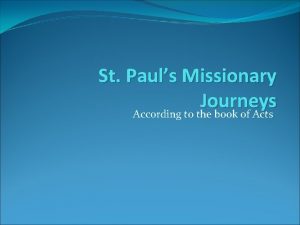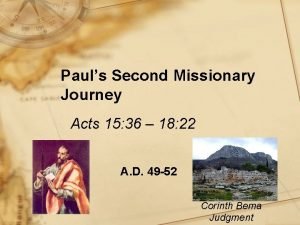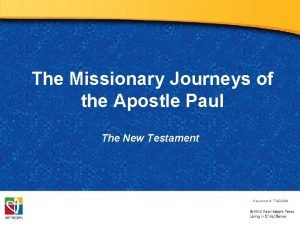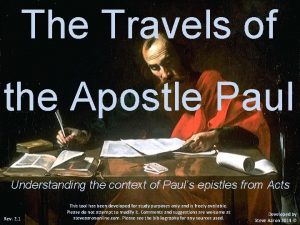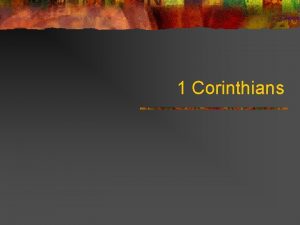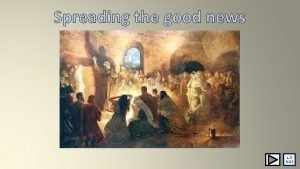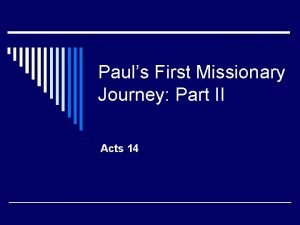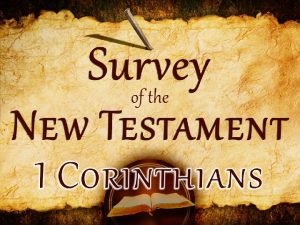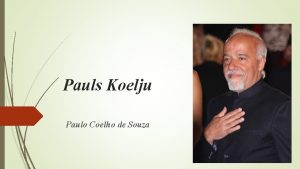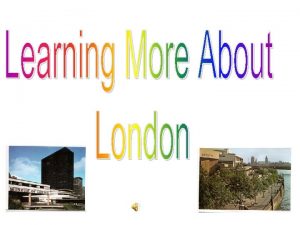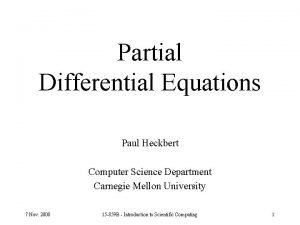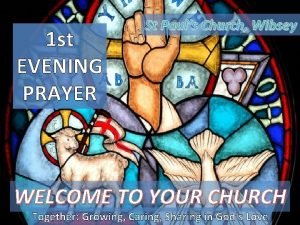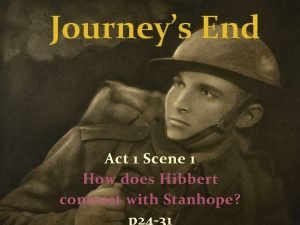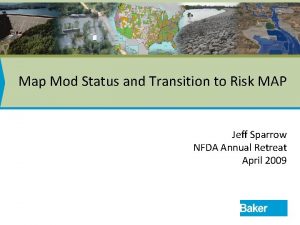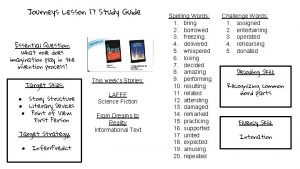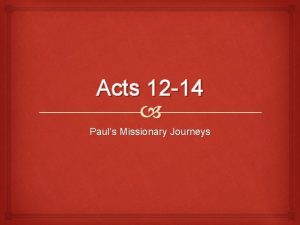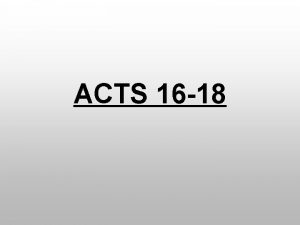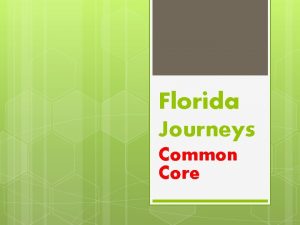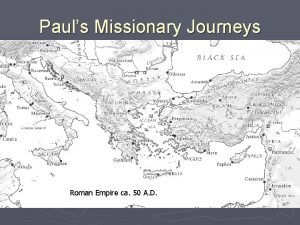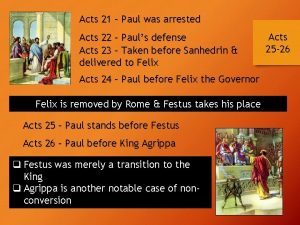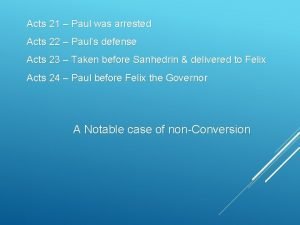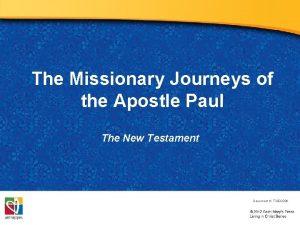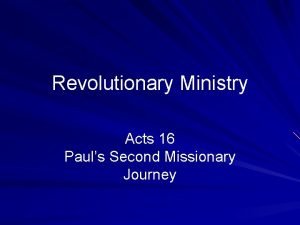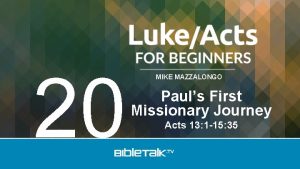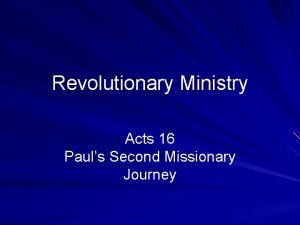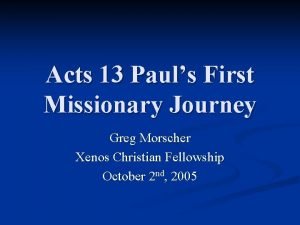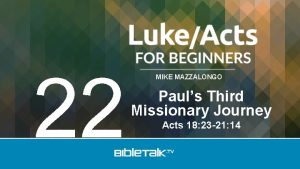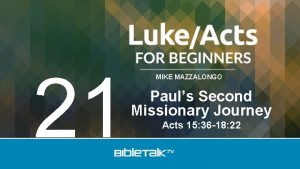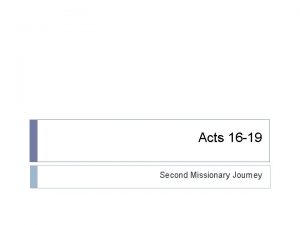ACTS PAULS MISSIONARY JOURNEYS Paul had encountered a




























- Slides: 28

ACTS – PAUL’S MISSIONARY JOURNEYS

Paul had encountered a vision from Jesus & was set to become its greatest proponent. Last 16 chpts. of Acts chronicle three missionary journeys that Paul took, spreading the gospel primarily outside Jewish world to Gentiles. These missionary trips solidified Christianity’s place in the world & assured that it would be more than a small Jewish sect.

PAUL’S FIRST JOURNEY • Took about three years – 46 -49 CE • Began in Antioch; continued to Cyprus & then Asia Minor (modern-day Turkey) • Accompanied by Barnabas


ACTS 15: 1 -21 – JERUSALEM CONFERENCE • First missionary journey interrupted by conflict between Jews & Gentiles regarding future of early church. • At issue: does one wishing to become a Christian have to become a Jew first (i. e. , be circumcised & keep Torah)? • Bitterly divided the early church – dangerous schism that threatened church’s future

ACTS 15: 1 -21 – JERUSALEM CONFERENCE • Peter & Paul speak out in favor of welcoming the Gentiles • Council decides “not to trouble Gentiles, ” allowing them to continue being Christians without becoming a Jew first • Monumental decision in the early church – why do you think? ?

PAUL’S SECOND JOURNEY • Took about two years – 50 -52 CE • Focus was on Greece – through Asia Minor & Galatia to Athens & Corinth • Companion this time was Silas (a falling-out with Barnabas over circumcision issue)


ACTS 16: 16 -40 – PAUL & SILAS IMPRISONED • In Philippi • Thrown into prison for healing a slave girl of spirit; owners couldn’t make $$ • In prison, earthquake broke chains lose. Jailer was going to kill himself, but Paul & Silas stayed. Jailer & his family were converted • Paul is freed b/c he’s a Roman citizen – free “get-out-of-jail” pass!

ACTS 17: 16 -34 – PAUL IN ATHENS • Paul surrounded by idols of Areopagus – very distraught. • Vs. 22 ff – Paul sees an “in!” What is it? To An Unknown God • Paul uses ideas & concepts familiar to Greek philosophy to make his case – Hebrew concepts wouldn’t have gotten him far • Paradigm of early church’s mission to Gentile world

PAUL’S THIRD JOURNEY • Took about four years – 54 -58 CE • Went from North Galatia to Ephesus, back to Athens & Corinth. • Spent up to 3 years in Ephesus


ACTS 21: 27 -40 – PAUL IMPRISONED • Second imprisonment, this time in Caesarea, on charges of sedition by Jews (24: 1 -9). Jailed for two years. • Highlights Paul’s difficulties w/Roman government in rest of Acts • 26: 1 -29 – Paul’s defense. Luke’s objective is to portray Christianity as no threat to Roman empire.

ACTS 27 – SHIPWRECKED & ON TO ROME • Paul’s boat shipwrecked in tricky waters/ wind of Crete, but recovers & heads to Rome • Arrives in Rome & speaks to Jews there, to no avail. Does have success speaking to Gentiles. • 28: 28 – Luke leaves no doubt about mission to Gentiles as future of church. Quotes Isaiah to defend this. • Why appropriate that Luke’s Acts should end in Rome? Represented totality of Gentile mission

SUMMARY OF ACTS • Second half of Luke’s account of Jesus’ life/early church • Mission to Gentiles portrayed as being the future of the church • Paul viewed as integral character in early church • Presents Christianity as legitimate religion that doesn’t threaten Roman government • Focuses only on movement of Christian faith to Asia Minor & Greece/Rome.

AN INTRODUCTION TO PAUL

PAUL’S IMPORTANCE TO THE CHURCH WHAT HE DID – HIS ACTIONS – Tireless mission trips helped early churches grow & flourish – Mission to Gentiles furthered growth of church to what it is today WHAT HE WROTE – HIS LETTERS – Almost half the entire NT attributed to Paul (13 letters) – Even if he didn’t write all of them, his influence still felt in all 13

PAUL’S IMPORTANCE TO THE CHURCH WHAT HE THOUGHT – HIS THEOLOGY – Much of what modern-day Christians believe about basics of God/Jesus/ Salvation comes directly from Paul’s views/interpretation. – Harris, 464: “There is perhaps more of Paul than Jesus in official Christianity. ” Thoughts? ?

BIO OF PAUL • Born 5 -10 CE in Tarsus as a Roman citizen as Saul. • Raised in Hebrew tradition while also brought up in Greek culture – a “Hellenized Jew. ” • Educated at home by his father & later at synagogue school. Was a Pharisee – protector of Torah. • As adult, persecuted followers of Christian movement – saw them as a threat to keeping purity of Torah.

PAUL’S CONVERSION EXPERIENCE • Accounted for in Acts 9 in dramatic fashion • Had vision of Jesus on road to Damascus that blinded him for three days. • Converted to Christianity with aid of Ananias & other followers (note Ananias’ hesitation in vs. 13). Name is changed to Paul. • Initially, Christians were reluctant to accept Paul. Jews saw him as a traitor.

PAUL’S MISSIONARY PATTERN • Paul would go to largest city in a region & “set up shop” at local synagogue. If synagogue didn’t work, he’d try a private home. Goal would be to start a church. • Would also set up in local marketplace (tentmaker by trade) to both make a living & evangelize. • Once church was established, Paul would go elsewhere.

PAUL’S MISSIONARY PATTERN • Paul would periodically check up on churches & correspond with them about issues they faced via his letters. • Letters were to be read in public for the entire church community & were often used as the sermon for worship.

PAUL’S LETTERS • 13 letters attributed to Paul. Probably 7 are truly written by Paul: Romans 1 & 2 Corinthians Galatians Philippians 1 Thessalonians Philemon • Other 6 are in question: 2 Thessalonians, Colossians, Ephesians, Titus, 1 & 2 Timothy.

PAUL’S LETTERS • Why disputed? • Vocabulary –not the same writing style & language Paul used • Theology – different from Paul • Pseudonymity – common practice to use the name of another to get your message heard. • Even so, these letters still were/are “authentic” messages to Christian community

PAUL’S LETTERS Paul’s letters had a common form: • Salutation – greetings from Paul to whomever the letter is addressed • Thanksgiving – Thanksgiving & prayers offered to the community. Would recognize & celebrate what church was doing.

PAUL’S LETTERS Paul’s letters had a common form: • Body – Main part of the letter & where Paul addresses his reason for writing: – sharing his theology and views – Discussing issues in the church that concerned him – seeking support for mission efforts • Parenesis – Advising & last instructions • Closing – Travel plans, blessings and parting words.

PAUL’S THEOLOGY Much of what the church today believes comes directly from Paul’s theology Some highlights: • God reveals God’s self through Jesus Christ • Centrality of Jesus & change Jesus offers to humanity • The church as the “body of Christ” • Justification by faith & not by law/Torah (quite a change!)

PAUL’S THEOLOGY Much of what the church today believes comes directly from Paul’s theology Some highlights: • Three important covenants in history of God's people: – Covenant with Abraham (promise of land) – Covenant with Moses (promise of nationhood) – Covenant with Jesus Christ (promise of salvation for all)
 St paul's missionary journeys
St paul's missionary journeys 2nd missionary journey
2nd missionary journey The missionary journeys of the apostle paul
The missionary journeys of the apostle paul Timeline of paul's missionary journeys
Timeline of paul's missionary journeys Paul second journey map
Paul second journey map Quiz 1: the early missionary journeys
Quiz 1: the early missionary journeys How powders containing potent drugs are dispensed
How powders containing potent drugs are dispensed Paul first missionary journey map
Paul first missionary journey map Apostle paul's third missionary journey map
Apostle paul's third missionary journey map Eportal st pauls
Eportal st pauls I must have drunk four cups of cocoa
I must have drunk four cups of cocoa Pauls koelju
Pauls koelju Nyandoche ibere
Nyandoche ibere Monasterevin secondary school
Monasterevin secondary school St pauls cathedral
St pauls cathedral Classification of pde examples
Classification of pde examples St pauls school wibsey
St pauls school wibsey I ... (to have) breakfast before i went to school.
I ... (to have) breakfast before i went to school. Never before she had eaten
Never before she had eaten Journeys end context
Journeys end context Journey's end act 1
Journey's end act 1 Journeys map mod
Journeys map mod Osborne journey's end
Osborne journey's end Journeys into the heart
Journeys into the heart Journeys reading curriculum
Journeys reading curriculum Journeys antarctic journal comprehension test
Journeys antarctic journal comprehension test Turnaround open jaw
Turnaround open jaw Journey's end ending
Journey's end ending Parallel journeys chapter summaries
Parallel journeys chapter summaries
